High Impact Tutoring Built By Math Experts
Personalized standards-aligned one-on-one math tutoring for schools and districts
In order to access this I need to be confident with:
Types of angles Parallel lines Equilateral triangle 2D shapes Polygons ParallelogramSum of exterior angles of a polygon
Here you will learn about how to find the sum of exterior angles of a polygon using a single exterior angle and use this knowledge to solve problems.
Students will first learn about this topic as a part of high school geometry.
What is the sum of exterior angles of a polygon?
The sum of the exterior angles of a polygon is always 360^{\circ} regardless of the number of sides the polygon has. This is also referred to as the polygon exterior angle sum theorem.
The exterior angles are angles between a polygon and the extended line from the vertex of the polygon.
Sum of exterior angles of a polygon =360^{\circ}
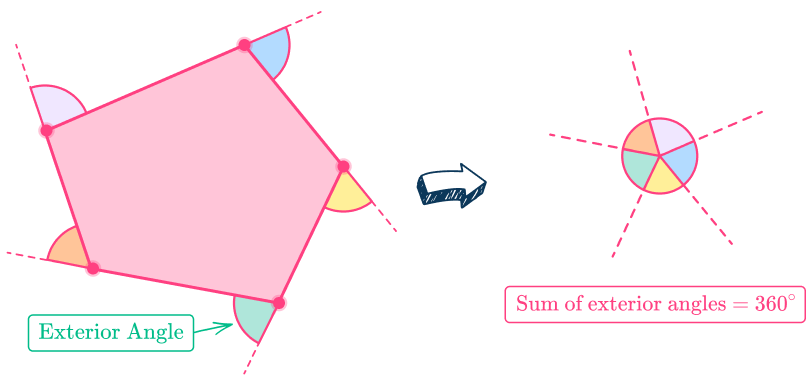
The interior angle and exterior angle at a vertex form a straight line so they add to 180^{\circ}.
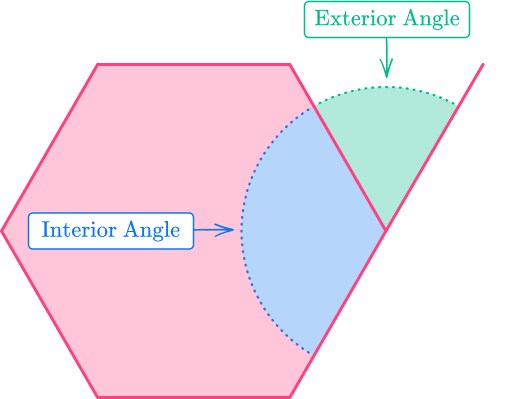
For a regular polygon, each exterior angle is the same and is calculated using the formula
E=\cfrac{360}{n}where E represents one exterior angle and n is the number of sides of the regular polygon.
As always, the angle \theta is measured in degrees, ^{\circ}.
What is the sum of exterior angles of a polygon?
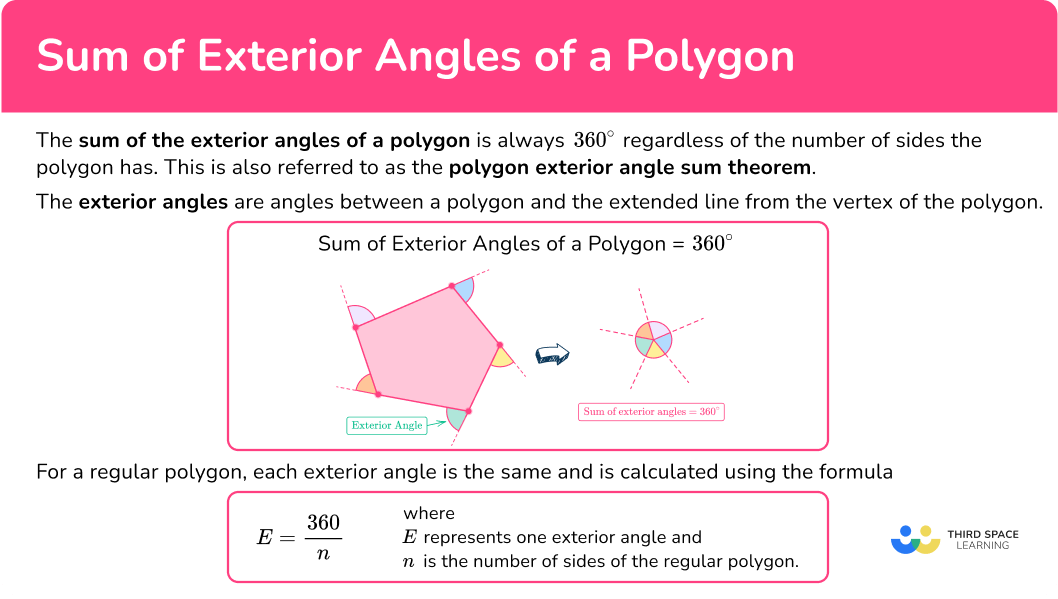
Common Core State Standards
How does this relate to high school math?
- High school: Geometry (HS.G.CO.C.10)
Prove theorems about triangles. Theorems include: measures of interior angles of a triangle sum to 180^{\circ}; base angles of isosceles triangles are congruent; the segment joining midpoints of two sides of a triangle is parallel to the third side and half the length; the medians of a triangle meet at a point.
![[FREE] Angles Check for Understanding Quiz (Grade 4)](https://thirdspacelearning.com/wp-content/uploads/2023/08/Angles-check-for-understanding-quiz-listing-image.png)
[FREE] Angles Check for Understanding Quiz (Grade 4)
![[FREE] Angles Check for Understanding Quiz (Grade 4)](https://thirdspacelearning.com/wp-content/uploads/2023/08/Angles-check-for-understanding-quiz-listing-image.png)
Use this quiz to check your grade 4 students’ understanding of angles. 10+ questions with answers covering a range of 4th grade angles topics to identify areas of strength and support!
DOWNLOAD FREE![[FREE] Angles Check for Understanding Quiz (Grade 4)](https://thirdspacelearning.com/wp-content/uploads/2023/08/Angles-check-for-understanding-quiz-listing-image.png)
[FREE] Angles Check for Understanding Quiz (Grade 4)
![[FREE] Angles Check for Understanding Quiz (Grade 4)](https://thirdspacelearning.com/wp-content/uploads/2023/08/Angles-check-for-understanding-quiz-listing-image.png)
Use this quiz to check your grade 4 students’ understanding of angles. 10+ questions with answers covering a range of 4th grade angles topics to identify areas of strength and support!
DOWNLOAD FREEHow to solve problems involving the sum of exterior angles of a polygon
In order to solve problems involving exterior angles of a polygon:
- Identify the number of sides of any polygon(s) and note whether they are regular or irregular polygons.
- Identify what the question is asking and recall the sum of exterior angles.
- Use the known information and any correct formula to solve.
Sum of exterior angles of a polygon examples
Example 1: finding the size of a single exterior angle for a regular polygon
Find the size of a single exterior angle for a regular hexagon.

- Identify the number of sides of any polygon(s) and note whether they are regular or irregular polygons.
A hexagon has 6 sides. These sides are all regular, and therefore all exterior angles are equal.
2Identify what the question is asking and recall the sum of exterior angles.
The question is asking to find the size of one exterior angle. The sum of exterior angles for a polygon is 360^{\circ}.
3Use the known information and any correct formula to solve.
360 \div 6=60The size of each exterior angle is 60^{\circ}.
Example 2: finding an exterior angle given an interior angle for an irregular polygon
An irregular octagon has one interior angle of size 130^{\circ}. What is the size of the adjacent exterior angle?
Identify the number of sides of any polygon(s) and note whether they are regular or irregular polygons.
An irregular octagon will have 8 sides.
Identify what the question is asking and recall the sum of exterior angles.
As adjacent means next to, you are being asked to find the size of the exterior angle where the interior angle on the line is known.
Use the known information and any correct formula to solve.
Angles on a straight line add to 180^{\circ} and the interior angle is 130^{\circ}.
180-130=50^{\circ}
The exterior angle will be 50^{\circ}.
Example 3: interior + exterior angle = 180°
Find the measure of angle x.
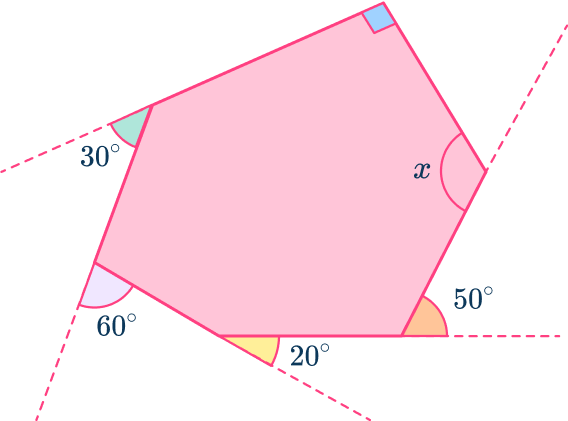
Identify the number of sides of any polygon(s) and note whether they are regular or irregular polygons.
An irregular hexagon has 6 sides.
Identify what the question is asking and recall the sum of exterior angles.
You need to find the interior angle x. It is an irregular polygon so the exterior angles and interior angles are not all equal.
The sum of exterior angles for a polygon is 360^{\circ}.
Use the known information and any correct formula to solve.
Find the missing exterior angle of the polygon first.
As one interior angle is 90^{\circ}, the exterior angle at this vertex is
180-90=90^{\circ}.
Subtract the 5 known exterior angles from 360^{\circ} to determine the unknown exterior angle.
360-(30+60+20+50+90)=110^{\circ}
The interior angle + the exterior angle must equal 180^{\circ} .
So x=180-110=70^{\circ}.
Example 4: finding the number of sides given the exterior angle of a regular polygon
An exterior angle of a regular polygon is 20^{\circ}. How many sides does the polygon have?
Identify the number of sides of any polygon(s) and note whether they are regular or irregular polygons.
The polygon has an unknown number of sides, or n sides.
It is a regular polygon, therefore all exterior angles are equal.
The sum of exterior angles for a polygon is 360^{\circ}.
Identify what the question is asking and recall the sum of exterior angles.
You need to find the number of sides, n.
You know the sum of the exterior angles is 360^{\circ} and that each exterior angle is equal because it is a regular polygon.
Use the known information and any correct formula to solve.
The polygon has 18 sides.
Example 5 : finding the number of sides given the interior angle of a regular polygon
The size of each interior angle of a regular polygon is 150^{\circ}. How many sides does the polygon have?
Identify the number of sides of any polygon(s) and note whether they are regular or irregular polygons.
The polygon has an unknown number of sides, or n sides.
It is a regular polygon, therefore all exterior angles are equal.
Identify what the question is asking and recall the sum of exterior angles.
You need to find the number of sides.
The sum of the exterior angles is 360^{\circ} and each exterior angle is equal because it is a regular polygon.
The sum of an interior and an exterior angle is 180^{\circ}.
Use the known information and any correct formula to solve.
If the interior angle is 150^{\circ} then the exterior angle will be 180-150=30^{\circ}.
The number of sides can therefore be calculated by 360\div{30}=12.
The polygon has 12 sides.
Example 6: multi step problem involving interior and exterior angles
The size of each interior angle of a regular polygon is 11 times the size of each exterior angle. Work out the number of sides the polygon has.
Identify the number of sides of any polygon(s) and note whether they are regular or irregular polygons.
The polygon has an unknown number of sides, or n sides.
It is a regular polygon, therefore all exterior angles are equal.
Identify what the question is asking and recall the sum of exterior angles.
You are given the number of sides of the polygon.
Other Information to consider:
- Total of exterior angles =360^{\circ}
- Interior + Exterior angle =180^{\circ}
- 11\times\text{Interior angle}=\text{Exterior angle}
Use the known information and any correct formula to solve.
You can call each of the interior angles x.
Since 11\times\text{interior angle}=\text{exterior angle}, each exterior angle can be called, 11x.
Therefore,
The size of one exterior angle is 15^{\circ}.
The number of sides of the polygon is 360 \div 15=24.
The polygon has 24 sides.
Teaching tips for sum of exterior angles of a polygon
- Provide students with a step-by-step proof that shows that the sum of exterior angles of any polygon will always add up to 360^{\circ}.
- Instead of providing students with worksheets to practice with, allow students to work in pairs or small groups to practice. This allows students the ability to collaborate and explain their thinking and reasoning in their own words.
- Get students to investigate the interior and exterior angles of polygons by drawing and measuring these angles.
Easy mistakes to make
- Confusing exterior and interior angles
The exterior angle of a triangle is the angle between the side and the extension of an adjacent side. Here the interior angle (internal angle) is 60^{\circ}, so the exterior angle (external angle) must be 120^{\circ}.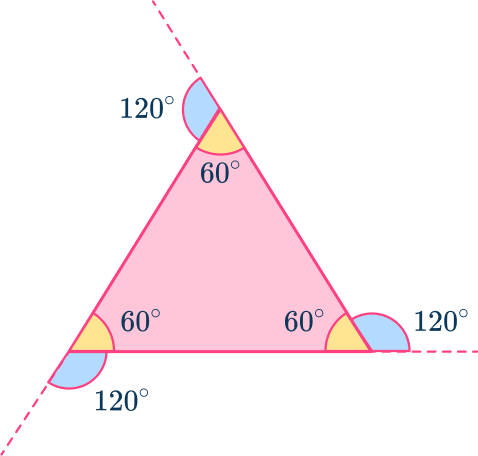
- Incorrectly assuming all the angles are the same size
The sum of exterior angles will always be 360 degrees, regardless of the number of sides. More sides does not mean the sum of all exterior angles will be greater than a polygon with less shapes.
- Misunderstanding regular vs. irregular polygons
Students may believe that irregular polygons follow another set of rules than regular polygons. Regardless if the polygon is regular or irregular, the sum of the measures of the exterior angles will always be 360 degrees.
Related angles in polygons lessons
Practice questions for sum of exterior angles of a polygon
1. Find the size of one exterior angle for a regular quadrilateral.




Exterior angles of a polygon add up to 360^{\circ}.
A regular quadrilateral has 4 interior angles equal in size, so the four exterior angles are equal.
This means you can divide 360 by 4 to get the solution.
360\div{4}=90^{\circ}
2. Find the size of one exterior angle for a regular octagon.




Exterior angles of a polygon add up to 360^{\circ}.
A regular octagon has 8 interior angles equal in size, so the eight exterior angles are equal.
This means you can divide 360 by 8 to get the solution.
360\div{8}=45^{\circ}
3. Find the size of one exterior angle for a regular nonagon.




Exterior angles of a polygon add up to 360^{\circ}.
A regular nonagon has 9 interior angles equal in size, so the nine exterior angles are equal.
This means you can divide 360 by 9 to get the solution.
360\div{9}=40^{\circ}
4. Each of the exterior angles of a regular polygon is 12^{\circ}. How many sides does the polygon have?
12 sides

20 sides

30 sides

32 sides

Exterior angles of a polygon add up to 360^{\circ}. This means you can divide 360 by 12 to get the solution.
5. Each of the exterior angles of a regular polygon is 20^{\circ}. How many sides does the polygon have?
12 sides

20 sides

16 sides

18 sides

Exterior angles of a polygon add up to 360^{\circ}. This means you can divide 360 by 20 to get the solution.
360\div{20}=18
The polygon has 18 sides.
6. Four interior angles in a pentagon are 125^{\circ} each. Find the size of the other angle.




The four known exterior angles will be 55^{\circ}, since angles on a straight line add to 180.
This means the fifth exterior angle will be 140^{\circ} because exterior angles add up to 360^{\circ}.
360-(55\times{4})=140^{\circ}
Using angles on a straight line once more leads us to find out the missing angle is 40^{\circ}.
7. Find the measure of angle x.
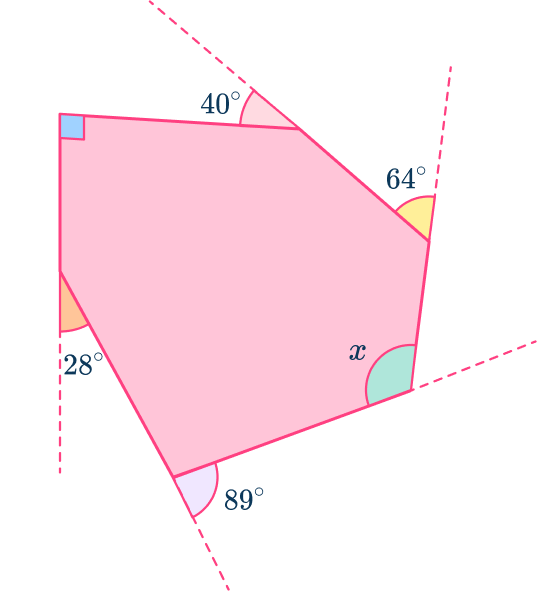




The four known exterior angles are 40^{\circ}, \, 64^{\circ}, \, 28^{\circ}, and 89^{\circ}.
As one interior angle is 90^{\circ} and the sum of the interior and exterior angle at a vertex is 180^{\circ}, the exterior angle at this vertex is 180-90=90^{\circ}.
As exterior angles add up to 360°,
360-(40+64+28+89+90)=49^{\circ}
Using angles on a straight line once more leads us to find out the missing angle is 180-49=131^{\circ}.
Sum of exterior angles of a polygon FAQs
A polygon is a two dimensional shape with at least three sides, where the sides are all straight lines. There are two key types of polygons.
1) A regular polygon is where all angles are equal size and all sides of a polygon are equal length (a square), and 2) An irregular polygon where all angles are not equal size and/or all sides are not equal length (a trapezoid).
The sum of exterior angles of any polygon is always 360^{\circ}, regardless of the number of sides the polygon has.
For a regular polygon, the exterior angles can be found using the formula
\text{exterior angle}=\cfrac{360^{\circ}}{n}, where n, is the number of sides of the polygon.
The sum of interior angles of a polygon can be found by using the interior angles formula: \text{sum of interior angles}=(n-2)\times{180}^{\circ}.
Unlike the sum of exterior angles, the sum of interior angles does change based on the number of sides of a polygon.
The next lessons are
- Congruence and similarity
- Transformations
- Mathematical proof
- Trigonometry
Still stuck?
At Third Space Learning, we specialize in helping teachers and school leaders to provide personalized math support for more of their students through high-quality, online one-on-one math tutoring delivered by subject experts.
Each week, our tutors support thousands of students who are at risk of not meeting their grade-level expectations, and help accelerate their progress and boost their confidence.

Find out how we can help your students achieve success with our math tutoring programs.
[FREE] Common Core Practice Tests (3rd to 8th Grade)
Prepare for math tests in your state with these 3rd Grade to 8th Grade practice assessments for Common Core and state equivalents.
Get your 6 multiple choice practice tests with detailed answers to support test prep, created by US math teachers for US math teachers!